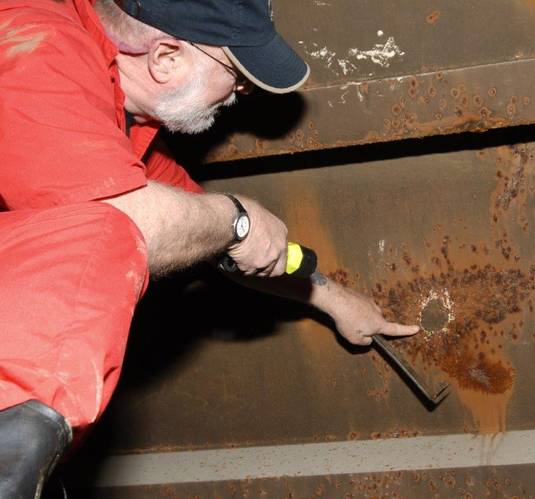Apples and Oranges When it Comes to Vessel Finance
Companies, lenders, and their auditors worldwide need vessel appraisals that can be relied upon when put into legal documents. As the offshore energy support markets awaken, this is more important now, than ever.
While a great deal of shipping finance is done at a 10,000' level, with bond deals and equity swaps, the value of the assets found on ground level are still very important. There are taxation issues, insured value, public reporting, and allocation of purchase price, where the value of individual vessels is important. Companies, lenders, and their auditors worldwide need vessel appraisals that can be relied upon when put into legal documents. How can an owner, lender, or auditor depend on values that may have been gathered from varied sources?
Uniformity in appraisal process started domestically with the collapse of the U.S. savings and loan market due to deregulation and fraud, among other causes. The involved parties, lenders and appraisers, in order to avoid direct government regulations, formed The Appraisal Foundation in order to self-regulate. This started in 1986 with multiple appraisal organizations starting to write the Uniform Standards of Professional Appraisal Practice (USPAP), and U.S. Congress, in 1989, passing the Financial Institution's Reform, Recovery, and Enforcement Act (FIRREA), officially making The Appraisal Foundation the overseer of appraisal standards and appraiser qualifications.
Today, in every state, any real property appraisal, residential or commercial, has to be done to USPAP standards by USPAP certified appraisers. While this began as the standard for real property, appraisal organizations followed suit and made USPAP the standard for any appraiser member, be they appraising gems and jewelry, antiques, factory equipment, construction equipment, entire factories or refineries, business organizations, or even intangibles, such as copyrights, patents, and stocks and bonds. Now U.S. banks have operational standards that require a USPAP compliant appraisal report for asset-based loans and other transactions that require auditing.
While the Appraisal Foundation and USPAP work well as a control within the United States, the scope of today's commerce has rapidly become worldwide. Abroad, a British group, the Royal Institute of Chartered Surveyors (RICS), which has been in existence for almost 150 years, has a set of ethics that are in many ways similar to USPAP. This is called the Red Book. While there are some RICS members all over the world, these scattered sources of unified organizational ethics cannot serve a financial web now connected to every country in the world.
This is where the apples and oranges come in. The United States and the United Kingdom have similar financial foundations and regulations, and with exceptions, a similar language. Once we move into many other countries, the similarities end. The Mideast looks at debt in a different way than the West. Japan has no history of asset based lending. So, how does a lender in London feel comfortable with an appraisal report from Zaire?
In the early 1980's, a group called The International Asset Valuation Standard Committee formed to develop consistent standards for worldwide real property appraisal. By 2008, it had morphed into the International Valuation Standards Committee. As of 2017, it included over 70 appraisal organizations worldwide, all who want their country and their appraiser members to have recognized appraisal reporting standards and ethics.
When a lender anywhere in the world reads an appraisal report, they want to feel that the standards, language, descriptions, and ethics being used are apples to apples or oranges to oranges.
The current 2017 International Valuation Standards (IVS) are in most ways similar to USPAP and the RICS Red Book. While the ethics portions are very similar, the rules for the appraisal processes are not as tightly drawn to allow appraisers in some foreign countries to comply with local laws.
Beside the compliance with ethical standards and avoidance of bias, all compliant appraisal reports, be they USPAP or IVS, must be transparent so that even a third party reader can follow the process that developed the value or values, and even some well written appraisals may end up being "cross-examined" by auditors in the case of appraisals involving ad valorem issues, allocation of purchase price in mergers and acquisitions, or other financial reporting situations.
While still rare, Dufour, Laskay & Strouse has seen requests for vessel appraisals from foreign banks that the appraisal report be IVS compliant. Having followed the formation of the international standards for almost a decade, compliance has not been a problem.
Though still not the worldwide standard, appraisal organizations in the major trading nations are moving to have their members, and their countries' laws, in line with the International Valuation Standards that produce ethical and transparent appraisal reports. Thus, all parties involved in an asset-based financial transaction can feel comfortable that the “apple,” with its qualities in question, is indeed an apple.
Mr. Norman Laskay is Of Counsel with Dufour, Laskay & Strouse, Inc., a full service marine surveying firm, with its main office in New Orleans, Louisiana. The company started in 1968 and has expanded its appraisal, insurance claim and cargo business and opened offices in Houston, Tampa, and Jacksonville. Laskay is a graduate of Maine Maritime Academy with a B.S. in Marine Transportation and has served as a deck officer for several Gulf Coast based steamship lines. He is a published author, has served on the Machinery and Technical Specialties (MTS) Committee of the American Society of Appraisers for 12 years where he is now an Emeritus member. He is also a Certified Marine Surveyor (CMS) with the National Association of Marine Surveyors (NAMS).
This article first appeared in the September print edition of MarineNews magazine




















